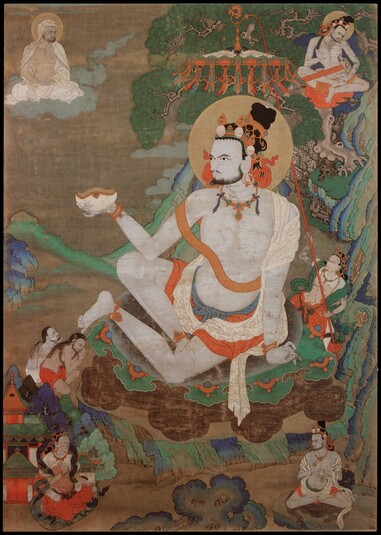
Item: Indian Adept (siddha) - Naropa
| Origin Location | Tibet |
|---|---|
| Date Range | 1700 - 1799 |
| Lineages | Kagyu, Drukpa (Kagyu) and Buddhist |
| Material | Ground Mineral Pigment on Cotton |
| Collection | Navin Kumar |
Naropa, Mahasiddha: one of the principal Tantric Buddhist siddha of India. He is counted in both the Vajrasana and Abhayadatta Shri systems of enumerating the eighty-four mahasiddha. These great accomplished ones are regarded as being the original human source for most if not all of the Tantric literature and practice traditions of Tantric Buddhism.

Naropa, pale in complexion, is seated in a relaxed posture facing to his right. The left hand is pressing against the seat supporting the body, which leans slightly back. The right hand holds a skullcup with the partially outstretched arm, the elbow resting on the knee. A meditation strap hangs loosely across the upper body. Adorned with jewelery and a crown of skulls Naropa characterizes the typical appearance of a Tantric Mahasiddha. A consort holds a parasol behind and two ascetics with disheveled hair kneel in front.
In the upper left corner is the siddha Lawapa (inscribed beneath), in the appearance of a yogi, wearing a white garment and seated in the posture of meditation. At the top right is Kukkuripa (inscribed beneath), the dog lover, in a similar apparance to Naropa except that the meditation strap is engaged and he cradles a dog at his side.
At the bottom right is the siddha Vajra Ghanta (inscribed beneath) holding a vajra and bell at the heart and seated in vajra posture on a deerskin. At the left is a female siddha, more commonly referred to as yogini (as inscribed beneath). She is likely to be the famous Lakshminkara, and like all of the other named figures in this composition, she belongs to the Abhayadatta Shri set of Eighty-four mahasiddha.
This painting belongs to a larger set of paintings depicting the Marpa Kagyu lineage of teachers, likely the Mahamudra Lineage of the Karma Kagyu (Kamtsangpa) sub-school of Marpa Kagyu. The central painting would be Vajradhara with a painting of Tilopa at the proper right of that painting. Both the Tilopa and the Naropa figures look in at the central figure of Vajradhara. Currently there are no other works from this set of paintings, likely numbering more than fifteen, known to exist.
Naropa figures prominently in many lineages of tantric practice - especially honoured in the early Marpa Kagyu lineage of teachers. The Tibetan Marpa Chokyi Lodro (1012-1099), founder of the Marpa Kagyu Tradition, having journeyed three times to India, studied extensively with Naropa. In the Sakya School Naropa is honoured as the originator of an important cycle of Vajrayogini practice counted as one of the very special teachings of Sakya. Lineages that include the name Naropa weave through all of the Sarma Schools of Tibetan Buddhism.
Jeff Watt 12-2005
Front of Painting
Wylie Transliteration of Inscription: la wa pa. ku ku ri pa. rdo rje dril bu pa. nal byor ma ...
Indian Adept (Mahasiddha) Art History
Indian Adept Main Page (Mahasiddha)
Definition: Heruka (siddha) Appearance
Indian Adept: Naropa Main Page
Collection of Navin Kumar Gallery (Painting Masterworks)
Painting Tradition: Lhatog, Khampa Gar
Indian Adept: Naropa Biography
Indian Adept: Mahasiddha Source Texts
Indian Adept: Siddha Appearance Masterworks (Painting)
Subject: Masterworks (Persons, 人物)
Indian Adept: Naropa (Masterworks)
Collection of Navin Kumar Gallery: Painting
Indian Adept (Mahasiddha): Painting (Late Period 17th to the Present)
Subject: Mahamudra Page
